I'm a world traveler but never heard of Bonaire until I visited. Here are 16 surprising things I learned about the Caribbean island.
Latifah Al-Hazza

- I recently traveled to the Caribbean island of Bonaire for the first time.
- I knew absolutely nothing about it before traveling there, but learned so much in just a week.
I recently left my home in the States to travel to the tiny island of Bonaire.
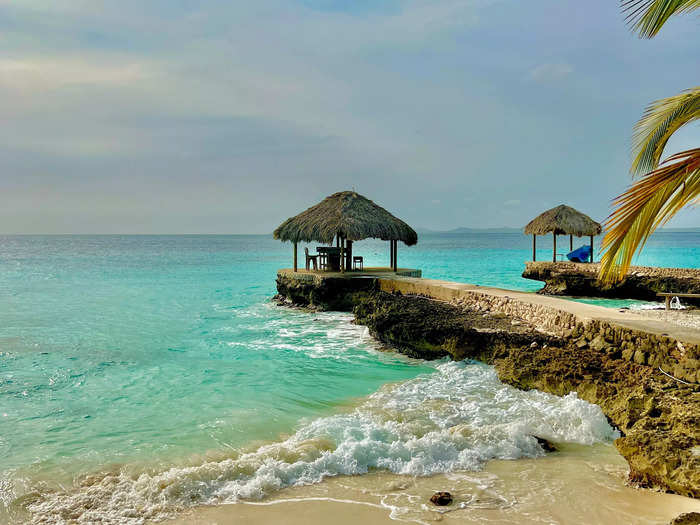
I currently live in Virginia Beach, Virginia, and consider myself a world traveler; to date, I've been to over 50 countries.
But there are still so many places left to discover. This became especially apparent to me last year when I was searching for the best places to get PADI scuba certified.
It was at that time that I came across the Caribbean island of Bonaire, which until that point, I had never even heard of.
Since I didn't have a friend or family member that had been to Bonaire, everything about it was new to me. I initially wrongly assumed the island's only claim to fame was its diving given the reputation, but I quickly learned that I was wrong in the best way possible.
Here are 16 things I learned about the island when I spent a week there in 2022 that greatly surprised me.
It's the smallest island I've ever been to in my travels.
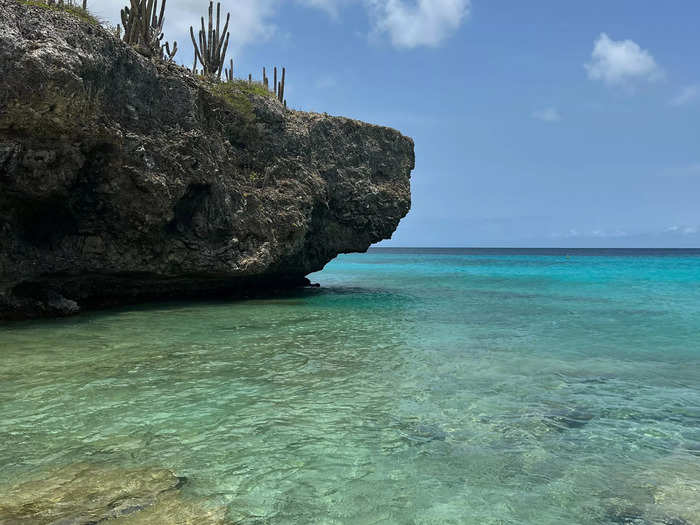
I've visited islands before, including three other Caribbean destinations, but none were as tiny as Bonaire.
The island is roughly 111 square miles, with a width that ranges from three to seven miles and a length of approximately 24 miles, according to Info Bonaire.
With such a small distance to cover, it only took me around four hours to drive around the entirety of the island.
I found out that Bonaire is not its own country but is part of a European country.
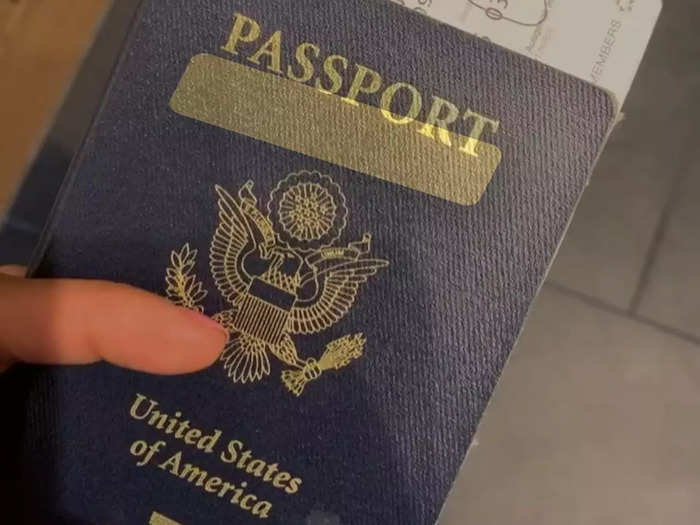
When I first learned about Bonaire and decided I wanted to visit, I wrongly assumed I'd be visiting the country of Bonaire.
But I learned it's actually an island municipality of the Netherlands, according to Britannica.
In fact, I learned that Bonaire is the "B" in the ABC islands (Aruba, Bonaire, Curacao) which are all Dutch-owned.
So while I still needed my passport to travel to Bonaire, I couldn't count it as a new country I was visiting apart from the Netherlands.
While I was surprised to learn Bonaire is part of Europe, I was more shocked to find that I never felt like I was in Europe while on this tropical island.
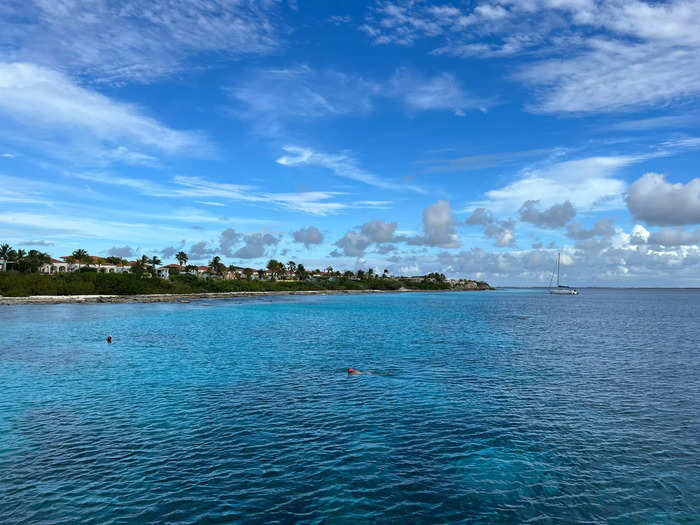
To date, I've traveled to 12 European countries. I'm quite familiar with the atmospheric sights that come with visiting the historic continent filled with ancient landmarks, cobblestone streets, and iconic cities.
But I didn't think that Bonaire looked or felt like Europe at all.
In fact, other than being surrounded by a majority of Dutch tourists while in Bonaire, I didn't notice many obvious signs of the island's ties to the Netherlands.
Dining out, most of the cuisine I ate was a mix of Caribbean, African, Latin, and Asian flavors. I didn't come across European or Dutch food.
I also thought that the pace of the island was much slower than I've experienced in Europe, and the majority of the locals I chatted with were originally from Venezuela or Curaçao, who told me they had never even been to The Netherlands or Europe.
I found this to be surprising and had to remind myself often that I was technically still in a European country.
I was shocked, and relieved, to learn that the island doesn't experience a hurricane season.
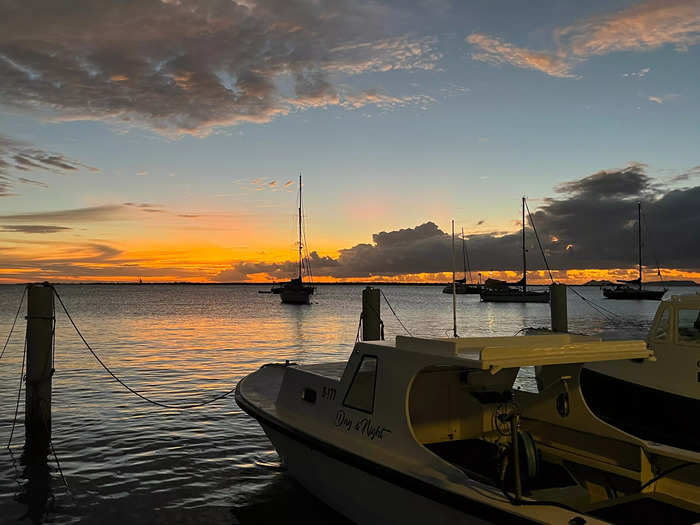
I traveled to the Caribbean in April, well ahead of hurricane season, which typically affects the region from June to November, according to Afar.
But even if I had traveled there a few months later, I wouldn't have had to worry about weather impacting my travels.
That's because Bonaire's location in the Caribbean next to Curaçao and Venezuela actually dodges hurricanes as it lies outside the main hurricane belt in the Caribbean, according to USA Today.
That makes it a great island to travel to if you're looking to visit the Caribbean during hurricane season, since it's rarely impacted by the natural disaster, according to the same source.
November is considered a rainy month but only sees about 4.7 inches of rain, according to Climate and Weather.
When I visited at the end of April, I didn't experience a day of clouds, cold, or rain.
I learned that the Bonairean native language is a mixture of many other languages.
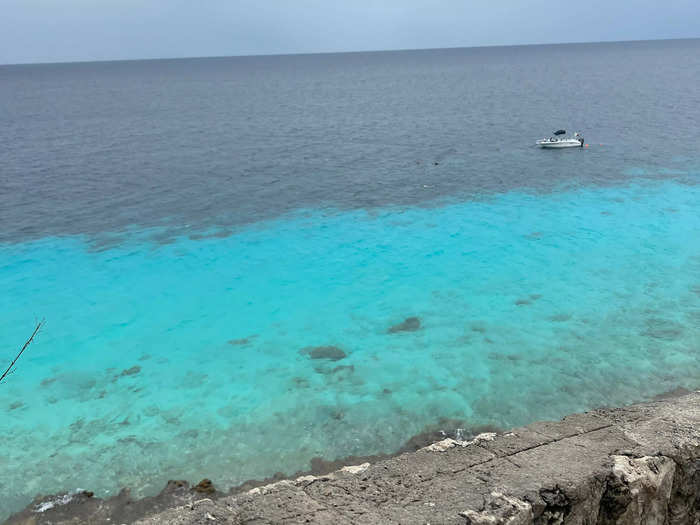
Most all people I met on Bonaire spoke English, but I was surprised to learn that while the official language is Dutch, the native language is Papiamentu, which is a mixture of Spanish, Dutch, Portuguese, and English, according to The New York Times.
According to the University of Hawaii, Papiamentu most likely was birthed from the pidgin Portuguese of the Africans, the Portuguese of the Jews, and a bit of Dutch from immigrants from the Netherlands. The emerging creole, which most likely was spoken in Curaçao around 1700, then spread to Bonaire and Aruba, according to the University of Hawaii.
Even though today, most people on the island speak four languages — Dutch, English, Spanish, and Papiamentu — English was the most widespread and that is what I got away with speaking during my stay.
I rented a car in Bonaire and couldn't believe that there are no traffic lights on the island. More commonly, I saw places to stop for various crossings.
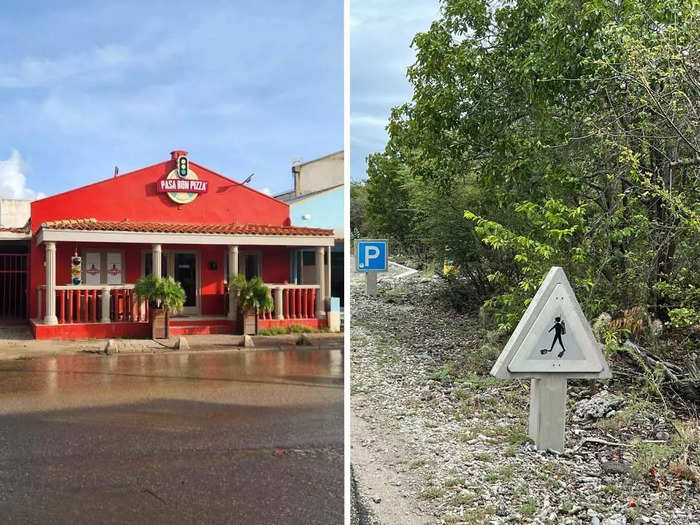
When I arrived on Bonaire, I decided to rent a car. I was unsure of the public transportation system, and since the island was so small, I figured it would be my best option for getting where I wanted to go easily.
But once I got into my car, I was surprised to see that there's not one single traffic light on the entire island.
I was shocked, especially when the only traffic light I saw was signage for a pizza parlor.
Instead, there are just colored signs that denote local traffic laws. The most common street sign I saw while driving around the island was to alert drivers of an area where scuba divers frequently cross the road.
I also saw signs for flamingo or donkey crossings.
Bonaire local Annette Emerenciana, who I met during my visit on the island, told me, "Because Bonaire is not overly developed, traffic lights are not really needed. We have a low population, so less traffic … aside from the occasional donkey on the road!"
After driving for a few days, I saw what she meant. It's a small island and I thought driving here was quite relaxed. By the end of my trip, I realized there was never a point in time while driving that I felt a stop light was needed, either.
I was greatly impressed by the marine life in Bonaire. As soon as I started spotting fish, I was reminded why I wanted to get PADI certified here.
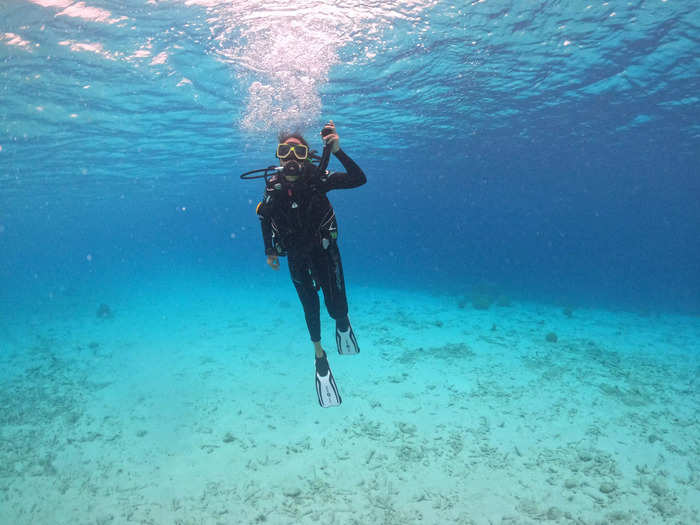
Last year, I wanted to get scuba certified in time for summer and needed to complete my PADI certification.
I was researching places to do it when I first heard about Bonaire, as it's considered one of the best places to dive in the world. Bonaire is also different from other Caribbean islands because they're the shore diving capital of the Caribbean, according to Girls That Scuba.
To get PADI certification, a diver is required to complete a certain number of dives in a pool, as well as a certain number of dives in open water, whether that's the ocean or lake, etc.
In order to maximize my time in Bonaire and not spend my entire trip taking scuba courses, I decided to take pool courses in Kuwait where I was staying at the time, before I traveled to Bonaire.
That way, all I had left to complete by the time I was to arrive in Bonaire was my open-water courses.
While taking these courses in two different locations with different instructors at first seemed daunting, I ultimately thought it was a great decision because I got to see all of Bonaire, not just its pools, and spend more time in the ocean. I also think I learned even more than I might have otherwise because I was able to glean information from two different instructors who each shared their own personal tips.
In Bonaire, I got certified at Buddy Dive, where I found the instructors to be laid-back and patient, so I was able to perfect each skill set before moving forward.
Once I started diving in Bonaire, I quickly understood why it had such a strong reputation. I didn't have to go far, or even on a boat, to see the diverse underwater world Bonaire hosts. Immediately , I spotted sea horses, frog fish, squid, and sea turtles, which also helped me to forget how nervous I was and reminded me of why I wanted to get certified in the first place.
I thought the underwater life was so incredible, yet I was still impressed to learn that Bonaire is home to the oldest marine reserve in the world.
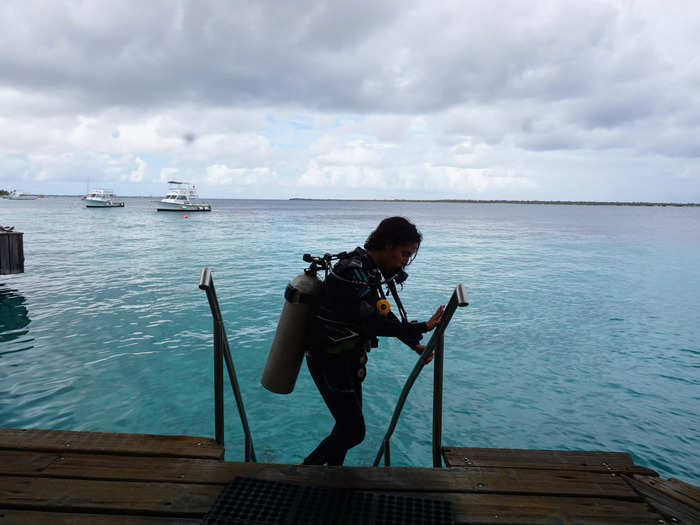
Bonaire's underwater life wowed me right away, and when I learned that it's the oldest marine reserve in the world, I was even more impressed.
Bonaire National Marine Park was established in 1979, according to US News & World Report, and its coral reefs are the least degraded in the entire Caribbean Sea, according to UNESCO It's where over 340 fish species call home.
According to Info Bonaire, the marine park was established to protect and preserve the underwater environment for generations to come.
In addition to scuba diving, I was also inspired to try windsurfing, which I didn't previously know would be so popular here.
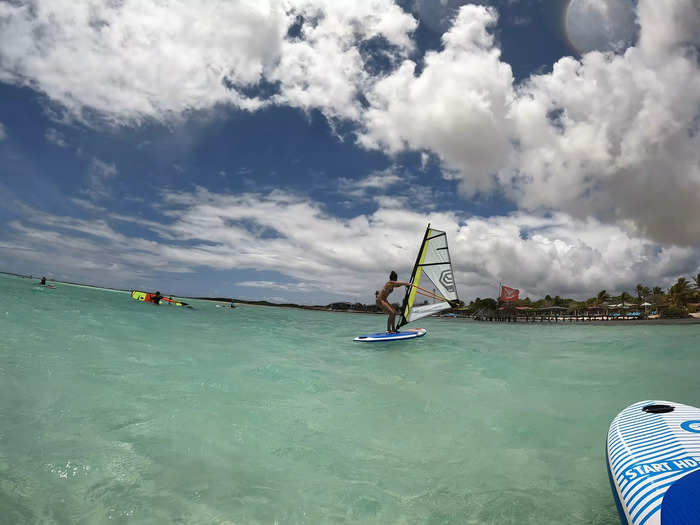
Men's Journal states that Bonaire is one of the most popular places in the world for windsurfing.
I didn't realize this until I arrived and saw so many people doing it. I decided I wanted to try it too.
I drove to Jibe City, a beach recommended by locals for windsurfing, and found a range of people from beginners to professionals out in the water.
Though I don't think I was very good, I had a blast and will definitely try it again.
After I checked windsurfing off my list, I was surprised to find yet another new sport to try.
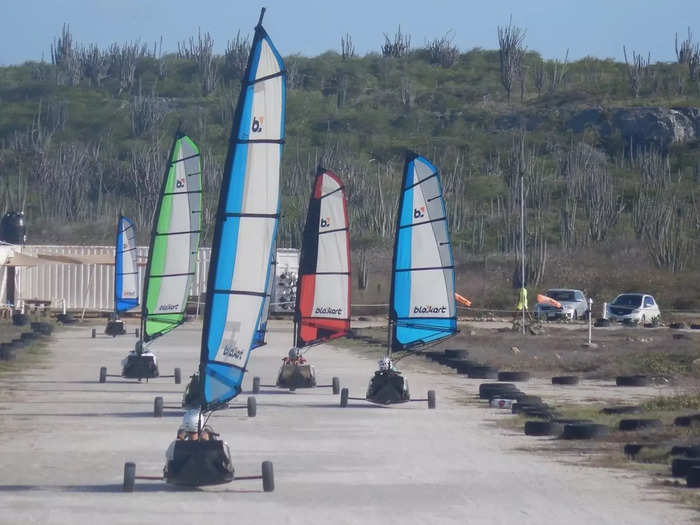
While I heard of windsurfing before my trip, I had never heard of landsailing. And it appeared to me to be very popular in Bonaire.
Landsailing involves three-wheeled wind-powered buggies with a large fin sail according to Thrillist. It's also known as land yachting.
Donna Hudgeon, coordinator of fun at Bonaire Landsailing Adventures, where I bravely attempted the sport, told me that "on Bonaire, we sail on land in blokarts, which come from New Zealand."
They're hand-controlled, three-wheeled karts with a steering bar and a rope attached to a sail for speed and once I got started, I thought it was an easy sport to pick up.
It was also an adrenaline rush that made me feel like a kid again. I especially loved learning how to landsail in Bonaire because the constant trade winds — the same ones that make windsurfing so popular — made me feel like a speed racer.
While I expected that Bonaire would have impressive marine life, I was surprised to see it is home to many land animals as well.
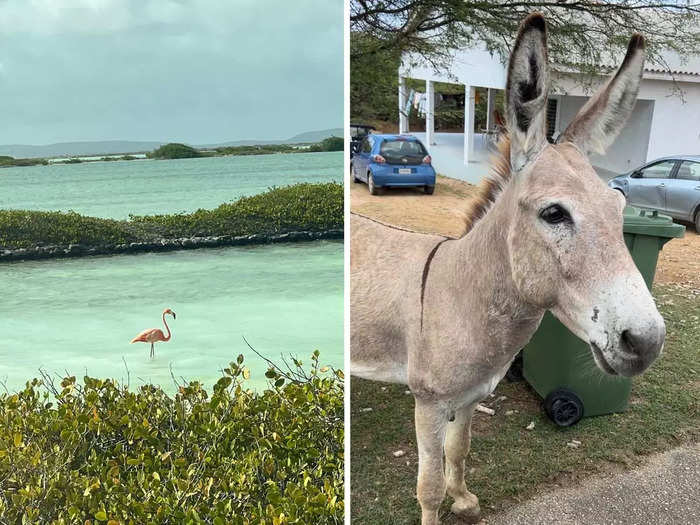
Marine life aren't the only animals who thrive in Bonaire.
Flamingos breed here according to the Dutch Caribbean Biodiversity Database, and as reported in US News & World Report, Bonaire's flamingo sanctuary is one of only four areas in the world where the American Flamingo breeds.
I spotted a number of these pink beauties in the north and south of Bonaire, and thought they were the most spectacular when they fly. According to multiple locals I spoke with while visiting, rumor has it there used to be more flamingos than people on the island.
Flamingos are so prevalent, my passport stamp when I landed also included a flamingo. And according to Info Bonaire, the airport was dubbed Flamingo Airport due to the flamingo pink color of the building.
I also saw many donkeys. Donkeys were originally brought to Bonaire by the Spaniards in the 17th century and used for labor, according to the Huffington Post. And according to the same source, today there are over 400 donkeys being cared for at the Donkey Sanctuary Bonaire.
I visited the sanctuary, located towards the south of the island, and witnessed donkeys of all ages being cared for, including sick, injured, and orphaned donkeys.
Another thing I did not expect to see in Bonaire were so many non-swimmable pink ponds.
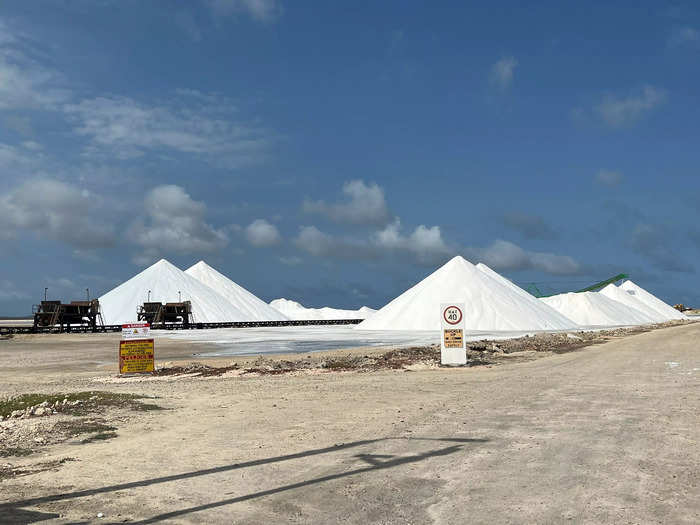
Driving around in Bonaire, I passed a large pink lake with several white pyramids around it.
I had no idea what I was looking at, but when I went to get a closer look, I was unable to as there were security personnel all around the area.
After researching what I saw and asking locals, I learned that Bonaire has many salt pyramids. Each pyramid is about 50-feet high and contains approximately 10,000 metric tons of 99.6% pure salt, according to Bonaire Sea Salt, and that a private company draws saltwater directly from the Caribbean, by moving it through a series of condenser ponds.
Bonaire Sea Salt also reports that the salinity increases due to the sun and wind, which causes evaporation of the water. The rise in temperature then causes a change in the organisms that live in the water, thus, changing its color to pink, according to the same source.
Rolando Marin of Bonaire's Tourism Board told me, "eventually it will form a layer of pure salt which is harvested, washed in sea water, and then stacked into Bonaire's iconic salt pyramids."
On an island so small, I didn't realize I'd have access to several great hiking trails.
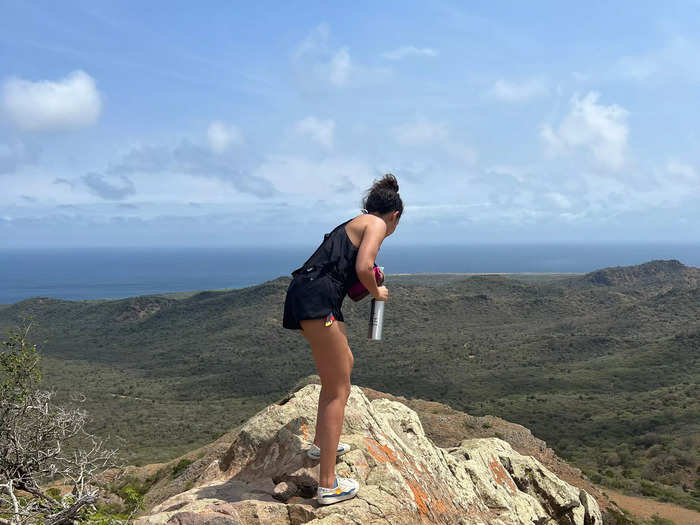
Given the island's small size, I was constantly amazed by how much there was to do here, especially activities that embraced the outdoors.
Hiking was one I didn't realize I'd do so much of, either.
My favorite trail was Brandaris at Washington Slagbaai National Park. It was well-marked, took about an hour, and according to Summit Post, is the highest point on Bonaire at an elevation of 791 feet.
I thought it had spectacular views, and I also saw iguanas, goats, and various types of birds during my hike.
When I was ready for a drink to celebrate all of my new accomplishments, I was pleased to try a liqueur that is only found on this Caribbean Island.
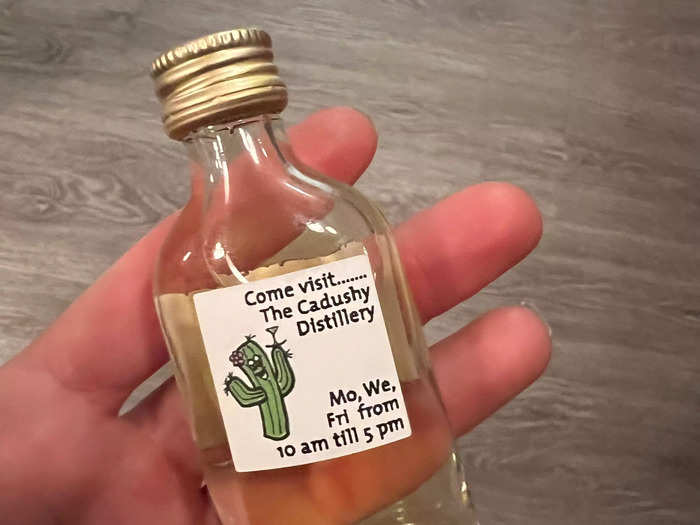
Bonaire is the only Caribbean Island that makes cactus liqueur, according to Carib Journal.
Eric Gietman makes it at Cadushy Distillery, which they say is the world's only liqueur made from cactus. I was able to see how it was made and then taste it. In my opinion, it was sweet but had a strong alcoholic kick.
I was also shocked that the island had so many phenomenal restaurants.
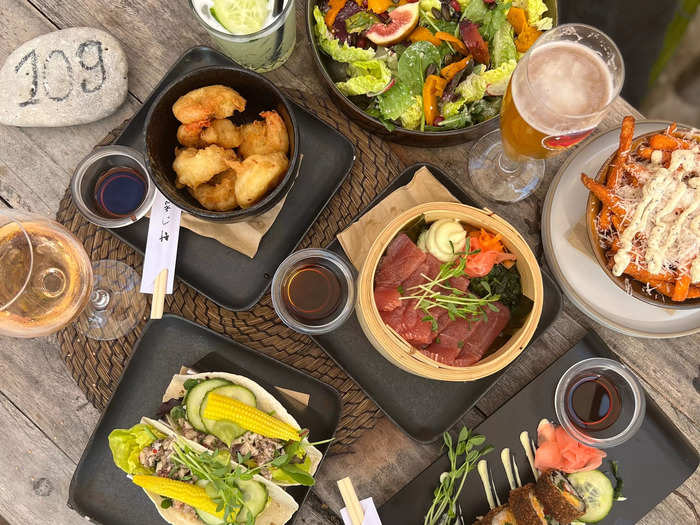
I didn't expect dining to be such a big part of my stay on Bonaire. It felt like each place I went prepared some of the best food I've ever tasted.
My favorites on the island were Sebastian's, which has a decadent international menu with a Mediterranean flair, and Blennies, a laid back, oceanfront restaurant where you can ditch your shoes to dine with sandy feed while drummers play Caribbean beats.
Senang was a fun restaurant for sushi platters on wooden boats, and Ocean Oasis made me feel like I was in Mykonos with a beach club vibe, including beachfront massages.
Tiki & Co was my go-to for a great cocktail, while Kite City served delicious tuna burgers from a food truck parked next to waves crashing onto the shore.
I also tried a local favorite, Iguana soup, which a waitress informed me is also known as Bonaire chicken. I am a pescetarian but had to try it, and did so at Karel's Beach Bar. I thought that Iguana does indeed taste like chicken. Karel's also serves goat brains with liver and intestine soup, though I declined both.
I had so much fun on the island, but learned while visiting that I was not allowed to take the beach home.
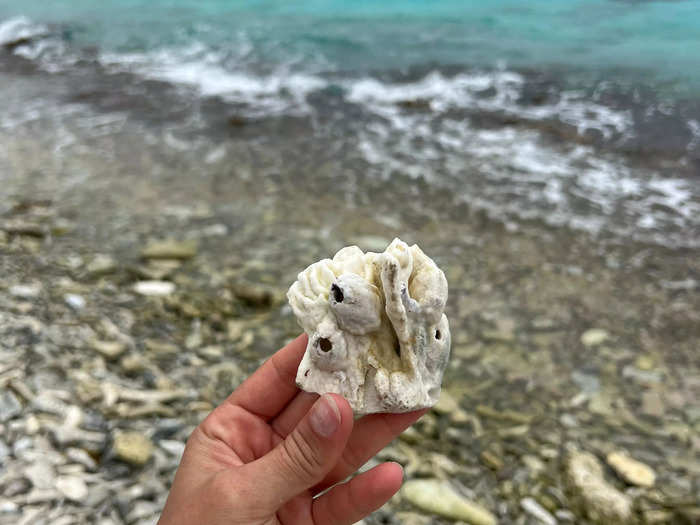
I saw so many beautiful pieces of coral washed up on the shores of Bonaire that I initially wanted to collect and take home.
But I learned that it's strictly forbidden to take shells, sand, and coral home, according to Info Bonaire. The same source reports that by prohibiting the collection of shells and coral, whether dead or alive, Bonaire ensures that international trade in specimens of wild animals and plants does not threaten their survival.
Airport officials will search your bags for these items and either confiscate them or penalize travelers, states Info Bonaire. Although, locals told me the latter is rare.
I might not have heard of Bonaire before this trip, but I'm glad I did, and I'll certainly be back.
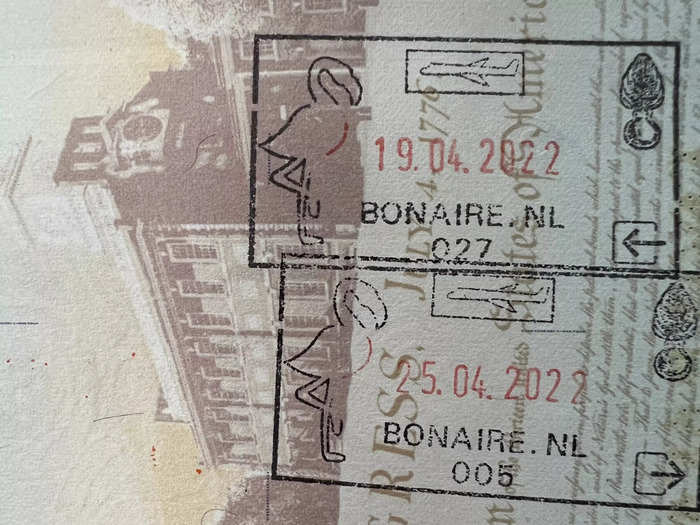
I loved my time in Bonaire and came away from my trip not only PADI certified, but with a new favorite place in the world that I hope to return to again very soon.
Popular Right Now
Popular Keywords
Advertisement